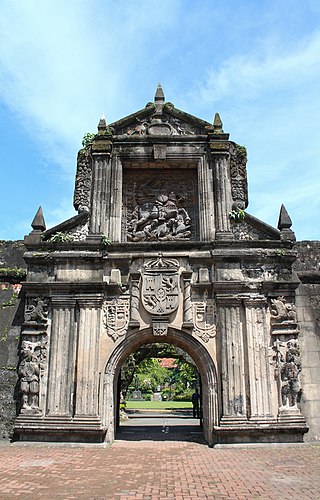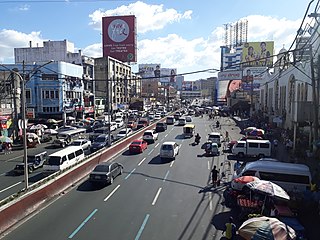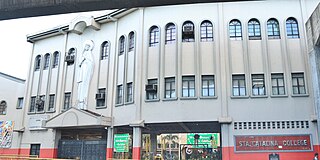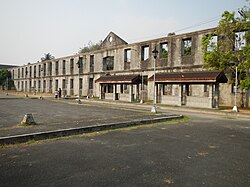
Intramuros, is the 0.67-square-kilometer (0.26 sq mi) historic walled area within the city of Manila, the capital of the Philippines. It is administered by the Intramuros Administration with the help of the city government of Manila.

Fort Santiago, built in 1571, is a citadel built by Spanish navigator and governor Miguel López de Legazpi for the newly established city of Manila in the Philippines. The defense fortress is located in Intramuros, the walled city of Manila.

The Congregation of the Religious of the Virgin Mary (Spanish: Religiosas de la Beata Virgen María, abbreviated RVM, is a Roman Catholic centralized religious institute of consecrated life of Pontifical Right for women founded in Manila in 1684 by the Filipina Venerable Mother Ignacia del Espíritu Santo.
The gates of Intramuros refer to the original eight gates of the Walled City of Intramuros in Manila, built during the Spanish colonial era in the Philippines. The gates are called by the original Spanish word for "gate", puerta.

Francisca del Espíritu Santo de Fuentes was a Spanish Roman Catholic religious sister. She was the first prioress of the Congregation of the Dominican Sisters of St. Catherine of Siena in the Philippines.

Quezon Boulevard is a short stretch of highway in Manila, Philippines running north–south through the district of Quiapo. It is a six- to ten-lane 1.1-kilometer-long (0.68 mi) divided boulevard designated as a component of National Route 170 (N170) of the Philippine highway network, except for its service roads, and Radial Road 8 (R-8) of Manila's arterial road network which links the center of Manila to North Luzon Expressway in Quezon City in the north. The boulevard is the main access to the popular Quiapo Church and is one of the main thoroughfares of the University Belt area.

The Elks Club Building is the second and former clubhouse of the Manila Elks Lodge #761—Manila Lodge 761, better known as the Manila Elks Club, in Manila, the Philippines. It was designed by William E. Parsons.

Historical markers are installed by the National Historical Commission of the Philippines (NHCP) and its predecessor agencies in the Philippines and places abroad that signify important and historic events, persons, structures, and institutions. The commemorative plaques are permanent signs installed by the NHCP in publicly visible locations on buildings, monuments, or in special locations. The NHCP also allows local municipalities and cities to install markers of figures and events of local significance, although these markers are barred from using the seal of the Republic of the Philippines.

Plaza San Lorenzo Ruiz or Plaza Lorenzo Ruiz is a major public square in Binondo, Manila, bounded by Quintin Paredes Street to the east and Juan Luna Street to the west, parallel to the Estero de Binondo. It is the plaza that fronts the Minor Basilica of San Lorenzo Ruiz, one of the main churches of the City of Manila, and is considered the center of Binondo as a whole.

Bonifacio Drive is a road running for approximately 1 kilometer (0.62 mi) in a north-south direction between Intramuros and Port Area in Manila, Philippines. The boulevard is also designated as Radial Road 1 (R-1) of Manila's arterial road network, National Route 120 (N120) of the Philippine highway network and an auxiliary route of Asian Highway 26 (AH26).

Santa Catalina College is a Roman Catholic, private institution that serves coeducational basic and higher education administered by the Congregation of the Dominican Sisters of St. Catherine of Siena, a religious congregation affiliated with the Dominican Order located in Sampaloc, Manila. It was originally established by the Siena Sisters in 1706.

The Ayuntamiento de Manila is a building located at the corner of Andrés Soriano Avenue and Cabildo Street, fronting Plaza de Roma in Intramuros, Manila, Philippines. Also known as the Casas Consistoriales and also nicknamed as the Marble Palace, the Ayuntamiento was the seat of the Manila City Council, which consisted of two alcaldes, eight oidores (judges), a clerk, and a chief constable. Destroyed in World War II and reconstructed thereafter, the building now houses the offices of the Bureau of the Treasury.

Cuartel de Santo Domingo, also known as Fort Sto. Domingo and Intramuros of Sta. Rosa, is an old two-storey Spanish barracks building in Santa Rosa, Laguna in the Philippines. It is currently used as the headquarters of the Special Action Force of the Philippine National Police.

Colegio de Santa Rosa - Manila is a private Catholic school run by the Congregation of the Augustinian Recollect Sisters in Intramuros, Manila, Philippines. It was established on August 30, 1750 as the Beaterio y Casa de Segunda Enseñanza by Mother Paula de la Santissima Trinidad to educate the young Spanish - Filipino women. It was originally an All Girls school until the early 2000 when it converted to a co-ed educational institution. It acquired its present name on 1774 but was also known by several other names including Colegio de Madre Paula and Beaterio y Casa de Enseñanza.

San Ignacio Church in Intramuros, Manila, Philippines, was designed for the Jesuits by architect Félix Roxas Sr., and completed in 1899. It was known as their "Golden Dream" but was destroyed during World War II. Its interiors, embellished with carvings, had been designed by Isabelo Tampinco.

The Santa Potenciana College or Colegio de Santa Potenciana was the first school for girls established in 1589 in the Philippines. It was intended to provide shelter for the orphans of the military personnel. The building was ruined by the 1645 earthquake. The site was later used for the construction of the Palacio del Gobernador. At present, the Philippine Veterans Building, Insurance Center Building, and the Philippine National Red Cross Main Office stand on its former site.

The Beaterio de Terciarias Agustinas Recoletas was the oldest convent for the Augustinian Recollect Order in the world established to meet the material and spiritual needs of pious women in the early part of the 18th century in the Philippines. The beaterio was founded by Dionisia de Santa Maria Mitas Talangpaz and Cecilia Rosa de Jesús Talangpaz, two Filipino sisters, both in blood and spirit, who hailed from barrio San Miguel of Calumpit, Bulacan. The convent's name was later changed to Beaterio de San Sebastian de Calumpang, but presently, it is now popularly known as the Congregation of the Augustinian Recollect Sisters. It is one of the three continuing congregation founded for native women in Asia after the Amantes de la Croix, was founded in Vietnam in 1670, and the Beaterio de la Compania de Jesus, now the Congregation of the Religious of the Virgin Mary, was founded in Manila in 1684. The original site of the beaterio was located inside Saint Rita College - Manila, one of the first three houses of the Augustinian Recollect Sisters, before it got damaged.

The Liwasang Bonifacio, also known by its former name, Plaza Lawton, is a city square and transport hub in front of the Manila Central Post Office in the Ermita district of Manila, Philippines. It lies at the south end of Jones Bridge, MacArthur Bridge, and Quezon Bridge that link the northern districts of Binondo, Santa Cruz, and Quiapo to the central district of Ermita. The plaza straddles the dividing line between Ermita and Intramuros and is the starting point of Padre Burgos Avenue which connects to Taft Avenue and Roxas Boulevard in Rizal Park.




















